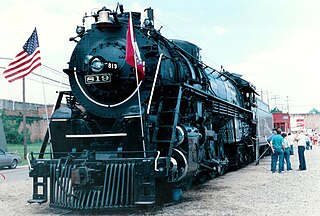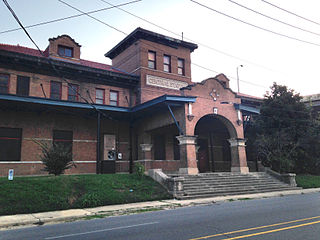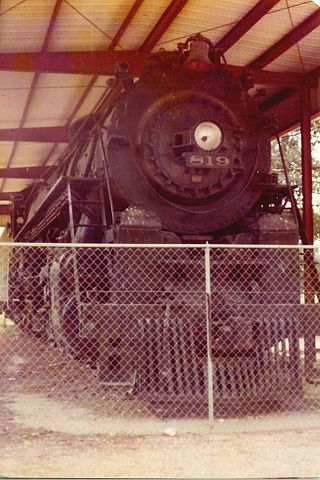
The St. Louis–San Francisco Railway, commonly known as the "Frisco", was a railroad that operated in the Midwest and South Central United States from 1876 to November 21, 1980. At the end of 1970, it operated 4,547 miles (7,318 km) of road on 6,574 miles (10,580 km) of track, not including subsidiaries Quanah, Acme and Pacific Railway and the Alabama, Tennessee and Northern Railroad; that year, it reported 12,795 million ton-miles of revenue freight and no passengers. In 1980 it was purchased by and absorbed into the Burlington Northern Railroad. Despite its name, it never came close to San Francisco.

The St. Louis Southwestern Railway Company, known by its nickname of "The Cotton Belt Route" or simply "Cotton Belt", was a Class I railroad that operated between St. Louis, Missouri, and various points in the U.S. states of Arkansas, Tennessee, Louisiana, and Texas from 1891 to 1980, when the system added the Rock Island's Golden State Route and operations in Kansas, Oklahoma, and New Mexico. The Cotton Belt operated as a Southern Pacific subsidiary from 1932 until 1992, when its operation was assumed by Southern Pacific Transportation Company.

The Central of Georgia Railway started as the Central Rail Road and Canal Company in 1833. As a way to better attract investment capital, the railroad changed its name to Central Rail Road and Banking Company of Georgia. This railroad was constructed to join the Macon and Western Railroad at Macon, Georgia, in the United States, and run to Savannah. This created a rail link from Chattanooga, on the Tennessee River, to seaports on the Atlantic Ocean. It took from 1837 to 1843 to build the railroad from Savannah to the eastern bank of the Ocmulgee River at Macon; a bridge into the city was not built until 1851.
Bird's Point is an unincorporated community in Mississippi County, Missouri, United States. It lies on an island or former island in the Mississippi River, near the confluence of the Ohio and Mississippi Rivers and is situated directly across from Cairo, Illinois. This is the point where the U.S. Route 60 bridge connects with Cairo.

Harvey Crowley Couch, Sr., was an Arkansas entrepreneur who rose from modest beginnings to control a regional utility and railroad empire. He is regarded as the father of Arkansas Power and Light Company and other electric utilities now part of Entergy; he helped mold the Louisiana and Arkansas Railway and the Kansas City Southern Railway into a major transportation system. His work with local and federal government leaders during World War I and the Great Depression gained him national recognition and earned him positions in state and federal agencies. He also established Arkansas' first commercial broadcast radio station.

Little Rock Union Station, also known as Mopac Station, is a train station in Little Rock, Arkansas, United States served by Amtrak, the national railroad passenger system.

The Lick Skillet Railroad Work Station Historic District is a historic district in Brinkley, Arkansas that was listed on the National Register of Historic Places in 1992.

Cotton Belt 819 is a class "L-1" 4-8-4 "Northern" type steam locomotive and is also the official state locomotive of Arkansas. It was completed in 1943 and was the last engine built by the St. Louis Southwestern Railway, which was affectionately known as "The Cotton Belt Route" or simply "Cotton Belt". It was also the last locomotive built in Arkansas. It was restored to operating condition in 1986 and operated in excursion service until October 1993. As of 2023, the locomotive is now located at the Arkansas Railroad Museum, currently being cosmetically restored.

Arkansas Railroad Museum is located on Port Road in Pine Bluff, Arkansas at the former Cotton Belt (SSW) yard.

Shreveport Central Station is a historic train station in Shreveport, Louisiana. It was built in 1910 by the Louisiana and Arkansas Railroad, a railroad that was eventually acquired by the Kansas City Southern Railway. By the opening of the 1940s the L&A and the St. Louis Southwestern Railway or 'Cotton Belt' moved its passenger operations from Central Station to Shreveport Union Station.

Twelve special routes of U.S. Route 63 currently exist. Arkansas and Missouri each contain five, with two in Iowa. There are also five former routings that have been removed from the system.

The Cotton Belt Freight Depot is a former freight depot of the St. Louis Southwestern Railway in the Near North Riverfront neighborhood of St. Louis, Missouri. It was listed on the U.S. National Register of Historic Places in 2004 and named "Best Old Building" by the Riverfront Times, a weekly newspaper in St. Louis.

The Cotton Belt Depot Museum is a museum located in the historic railroad depot in Tyler, Texas, United States.

The St. Louis Southwestern Railway of Texas, operated the lines of its parent company, the St. Louis Southwestern Railway within the state of Texas. The St. Louis Southwestern, known by its nickname of "The Cotton Belt Route" or simply the Cotton Belt, was organized on January 12, 1891, although it had its origins in a rail line founded in 1871 in Tyler, Texas that eventually connected northeastern Texas to Arkansas and southeastern Missouri. Construction of the original Tyler Tap Railroad began in the summer of 1875, and the first 21 miles out of Tyler to Big Sandy, Texas were constructed by early October of 1887. The line became the Texas and St. Louis Railway, and was completed between Gatesville, Texas and Bird's Point, Missouri by August 12, 1883, creating a continuous 725-mile system. However, that line promptly went into receivership, and was purchased by the St. Louis, Arkansas and Texas Railway in 1886. The assets of that company were acquired out of foreclosure by the St. Louis-Southwestern Railway in 1891. The St. Louis Southwestern of Texas merged with the property of the Tyler Southeastern Railway on October 6, 1899. The property of the Texas and Louisiana Railway was acquired and merged on July 2, 1903.

Union Station is a former railroad station at East 4th Ave. and State St. in Pine Bluff, Jefferson County, Arkansas. The station was originally at the union of the Cotton Belt and Iron Mountain railroads, and now houses the Pine Bluff/Jefferson County Historical Society museum. It is a single-story brick building, with a hip roof whose long eaves are supported by iron columns and half-truss brackets. The station was built in 1906 by the Iron Mountain Railroad. It had been a stop on the St. Louis Southwestern's Lone Star (Memphis-Dallas), and also on the railway's St. Louis-Dallas trains.

The Cotton Belt Railroad Depot is a historic railroad station at the junction of Main and 1st Streets in downtown Fordyce, Arkansas. The single-story brick building was built c. 1925 by the St. Louis Southwestern Railway, also commonly known as the Cotton Belt Railroad. The building is predominantly Craftsman in its styling, with extended eaves that have elaborately styled brackets.
The St. Louis San Francisco (Frisco) Railway Coach #661 is a historic railroad car. It was built in 1883 by the Barney and Smith Car Company of Dayton, Ohio, and served for many years on the St. Louis–San Francisco Railway. When built, it had wood sides and a canvas top; in 1936 the wood siding was covered with steel, and the roof is now a rounded fiberglass mesh that resembles the original canvas. It was acquired in 1996 by the Paperton Junction Southern Railway and restored. It is a rare surviving example of a 19th-century railroad car, with a separate compartment for African-American travelers.

The St. Louis Southwestern Railway Relief Train is a railroad rescue and recovery train, its elements now on display at the Arkansas Railroad Museum in Pine Bluff, Arkansas. The train's principal feature is a large steam crane, built by Industrial Brownhoist of Bay City, Michigan in 1940. Other elements of the train include a boom car, generator flat, kitchen car, tool car, and crew sleeper. The boom car, a low gondola car, was attached to the train below the projecting section of the train; the other elements of the train supported the crew and the operation of the crane to clear derailments. The relief train was assembled by the St. Louis Southwestern Railway, and remained in active service until 1996, when it was given to the museum.

The St. Louis Southwestern Railway Steam Locomotive #336 is a historic railroad steam locomotive, located at the Arkansas Railroad Museum in Pine Bluff, Arkansas. It is a Class D3 2-6-0 Mogul-style locomotive, built in 1909 by the Baldwin Locomotive Works in Philadelphia, Pennsylvania. She served on the St. Louis Southwestern Railway until 1947, and served industrial customers until 1963. It was placed on display in Lewisville, Arkansas until 1994, when it was donated to the museum. It is the last remaining 330-series locomotive used by the Cotton Belt.

The Cotton Belt Class L-1 was a class of 20 4-8-4 "Northern" type steam locomotives that were built by the Baldwin Locomotive Works and the St. Louis Southwestern Railway at their own Pine Bluff Shops.

















